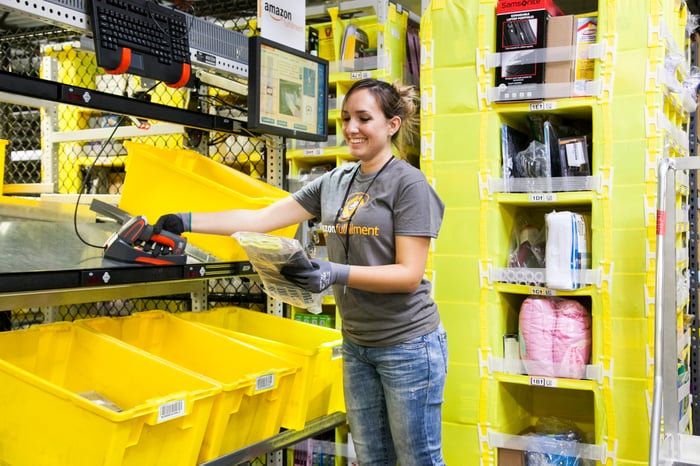This article was originally published on Fool.com. All figures quoted in US dollars unless otherwise stated.
Investing in 2020 hasn't been easy. The uncertainty created by the coronavirus pandemic ushered in a steep bear market decline during the first quarter, which was followed by a ferocious snap-back rally that took the S&P 500 Index (INDEXSP: .INX) to new highs.
Yet, while most investors and equities were suffering from volatility-induced whiplash, the FAANG stocks have been kicking butt and taking names.
These industry leaders have been unstoppable for some time
By FAANG, I'm referring to:
- Facebook Inc (NASDAQ: FB)
- Amazon.com Inc (NASDAQ: AMZN)
- Apple Inc (NASDAQ:AAPL)
- Netflix Inc (NASDAQ:NFLX)
- Google, which is a subsidiary of Alphabet (NASDAQ: GOOG)(NASDAQ: GOOGL)
On a year-to-date basis, the benchmark S&P 500 is up 6%, through to 21 October. By comparison, Facebook, Amazon, Apple, Netflix, and Alphabet are up a respective 36%, 72%, 59%, 51%, and 19% (rounded to include both Alphabet's Class A and Class C shares). These industry leaders are running circles around the broader market while, at the same time, propelling it higher. Remember, the FAANGs make up a sizable percentage of the market cap-weighted S&P 500.
But even with their collective 2020 outperformance, not all FAANG stocks are created equally. In my view, three of the five FAANGs still stand out as particularly attractive right now.

Image source: Facebook.
The first of the no-brainer buys is Facebook. Yes, it's faced its fair share of bad press in 2020, and it's seen its ad revenue hurt by the COVID-19 pandemic. But there are three key reasons Facebook's needle continues to point up.
First, advertising is a cyclical business – and last I checked, periods of economic expansion last substantially longer than periods of contraction or recession. Even though Facebook's ad growth has slowed to its lowest level since it became a public company, the long-term expansion of the US and global economy favors its ad revenue continuing to grow.
Second, advertisers can't go anywhere else to reach more than 3 billion pairs of eyeballs. In the June-ended quarter, Facebook boasted 2.7 billion monthly active users, along with 3.14 billion family monthly active users, which includes owned sites like Instagram and WhatsApp. Being the go-to social media site affords Facebook top-tier ad-pricing power.
Third, it's only monetising half of its assets. Currently, ads on Facebook and Instagram generate the bulk of the company's sales, with Facebook Messenger and WhatsApp not yet meaningfully monetised. That's four of the six most-visited social platforms in the world. The fact is, Facebook is still in the early to-middle innings of its growth phase, and that makes it worth buying.
As an added bonus, what if I told you Facebook was fundamentally cheap? Having averaged a price-to-cash-flow multiple of close to 24 over the past five years, Wall Street's consensus pegs the company at just over 11 time cash flow by 2023.

Image source: Getty Images.
Alphabet
Some folks might be a bit concerned with Alphabet considering that revenue actually fell on a year-over-year basis in the second quarter. That's the first time that's happened since it became a public company. But just like Facebook, all concerns about Alphabet appear to be overblown.
For starters, Google is the most dominant internet search platform in the world, and it's not even close. According to GlobalStats, Google's share of global search has ranged between 91.9% and 93% over the trailing 12 months. Just as advertisers are tripping over their feet to get their message in front of Facebook's huge audience, advertisers are also clamoring for placement on relevant Google search space. With periods of economic expansion lasting a long time, Alphabet's core business offers plenty of upside.
Alphabet is also home to two fast-growing operating segments: YouTube and Google Cloud. YouTube is one of the three most-visited social platforms on the web, and has thusly seen a big increase in ad revenue. In the June-ended quarter, YouTube ad revenue accounted for roughly 10% of the company's total sales.
But it's Google Cloud that could be the most exciting aspect of Alphabet. Cloud revenue surpassed $3 billion for the first time during the second quarter and actually grew 43% from the prior-year period. Remember, this growth comes in spite of the worst economic downturn for the US economy in decades. Since cloud margins are substantially higher than ad-based revenue, Alphabet's operating margins and cash flow are expected to expand rapidly as Cloud grows into a larger percentage of total sales.
After averaging a multiple of 18 times cash flow over the past five years, Alphabet is valued at less than 12 times Wall Street's consensus full-year cash flow for 2023. That's a bargain you shouldn't pass up.

Image source: Amazon.
Amazon.com
A third FAANG stock to buy hand over fist is e-commerce giant Amazon.com.
Unlike Facebook and Alphabet, Amazon has seen its business pick up in a big way since the pandemic hit. With consumers and people with pre-existing medical conditions less willing to leave their homes and shop in brick-and-mortar retail stores during a pandemic, Amazon's marketplace has become a logical destination. The June-ended quarter saw the company's net sales (i.e., not just e-commerce) catapult 40% from the prior-year period, with operating cash flow rising 42% to $51.2 billion.
Amazon remains, first and foremost, a retail entity. According to estimates from eMarketer in March 2020, Amazon is expected to increase its share of U.S. online sales from 37.3% in 2019 to 38.7% this year. For some context, that's over 33 percentage points higher than the next-closest competitor. Even with retail margins being razor thin, having this much clout in the online retail space has played a big role in the company signing up more than 150 million Prime members worldwide.
Like Alphabet, Amazon is also expected to see significant growth and cash flow expansion from its ancillary cloud infrastructure services business. Amazon Web Services (AWS) generated $10.8 billion in sales during Q2 2020, representing 29% sales growth from the prior-year period. We were already seeing small and medium-sized businesses pushing online prior to the pandemic. COVID-19 has accelerated this shift.
As AWS grows into a larger percentage of Amazon's total sales, its operating cash flow should soar. We're talking a possible tripling in operating cash flow per share between 2019 and 2024. If Amazon is simply valued at the midpoint of its cash flow multiple over the past decade, it should be a $3 trillion company within the next three or four years.
This article was originally published on Fool.com. All figures quoted in US dollars unless otherwise stated.









